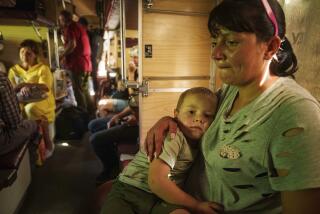Yugoslavia to Get Kosovo Zone Access
- Share via
BELGRADE, Yugoslavia — NATO agreed Thursday to allow Yugoslav troops to enter a buffer zone next to Kosovo and neighboring Macedonia that ethnic Albanian guerrillas have been using as a haven.
The action, aimed at cutting off routes used by the guerrillas, marks a further warming of the alliance’s ties with the Yugoslav government and another step in a growing confrontation between NATO-led peacekeepers in Kosovo and ethnic Albanian fighters near the borders of the separatist province.
“Of course we accept that offer,” Yugoslav President Vojislav Kostunica told a news conference here, while warning about the dangers his soldiers will face in the 3-mile-wide zone, established in mid-1999 to keep Yugoslav forces separated from the KFOR peacekeeping troops. NATO waged an 11-week air war against Yugoslavia in 1999 to stop an “ethnic cleansing” campaign against Kosovo Albanians.
“KFOR . . . is inviting our army to be in the cross-fire,” Kostunica said. “The army will of course do this, but it now undoubtedly has to make up for the mistakes of others.”
He charged that KFOR’s role in Kosovo--which is under U.N. administration but technically remains a province of Serbia, the dominant Yugoslav republic--has produced “disastrous” results. What is lacking, he said, is “more readiness to risk something, maybe more courage, on the part of NATO and KFOR.”
But on Kosovo’s southern border with Macedonia on Thursday, U.S.-led KFOR troops continued to show a newly aggressive stance, sweeping into the northern part of the Macedonian village of Tanusevci, which has been held by ethnic Albanian fighters since mid-February. Mindful of the sensitive issue of crossing borders, a KFOR spokeswoman stressed that the village straddles the Kosovo-Macedonian frontier.
The situation on the Macedonian side remained unclear, with conflicting reports on who controlled the rest of Tanusevci.
Late Thursday evening, Macedonian police in Skopje, the capital, told reporters that a Macedonian convoy near the border had come under attack, with a jeep blown up and its driver killed by a mortar shell or shoulder-launched grenade. The convoy was attacked a second time near the Macedonian village of Brest by guerrillas firing small arms, leading to a shootout that lasted about an hour. It was unclear whether there were casualties in the second attack.
In Brussels, George Robertson, the secretary-general of the North Atlantic Treaty Organization, issued a statement that “NATO is determined that those extremist elements seeking to sow instability or to advance their political agenda by violent means will be stopped, whether in southern Serbia, in . . . Macedonia or within Kosovo.”
Robertson said the alliance had authorized KFOR commander Carlo Cabigiosu “to allow the controlled return” of Yugoslav forces in a “narrow sector” of the buffer zone next to Macedonia.
A NATO spokesman in Brussels said that final approval for Yugoslav troops to enter the area could come this weekend but that it may take longer to work out the details. “The concept is that they would have light weapons, which would include assault rifles, sidearms, probably machine guns and probably light mortars,” he said. “It’s not an area where heavy armed vehicles would necessarily be useful.”
The guerrillas are armed with assault rifles, machine guns and rocket-propelled grenade launchers. Many observers say the rebels’ aim is to slice off parts of southern Serbia and northern Macedonia that are heavily ethnic Albanian in population and attach them to an ultimately independent “Greater Kosovo” or “Greater Albania.”
Kostunica said he hopes Yugoslav forces can enter the area by the end of March.
KFOR spokeswoman Capt. Alayne Cramer said Thursday that U.S. troops were continuing to work their way along the Kosovo-Macedonian border near Tanusevci, “looking for any illegal weapons or weapons caches . . . and trying to determine that there are no armed extremists.”
“On the map, when you look at the town of Tanusevci, part of the town falls in Kosovo,” she said. “There are buildings we’ve cleared, to make sure there are no people or weapons in those buildings.”
KFOR soldiers remained within Kosovo except for a small liaison team that has been working on the Macedonian side during the last few days, Cramer said.
“We have just concluded a successful operation by eliminating a safe haven for armed groups here in Kosovo,” U.S. Brig. Gen. Kenneth Quinlan told reporters accompanying KFOR troops. “We were . . . very careful to delineate this boundary between us and the Macedonian authorities. . . .”
The guerrillas in the part of Tanusevci that KFOR entered Thursday left without putting up resistance, Quinlan said.
KFOR troops found food, supplies and explosives in a school building the guerrillas had been using, said U.S. Lt. Col. Bryan Owens, who led the KFOR operation.
More to Read
Sign up for Essential California
The most important California stories and recommendations in your inbox every morning.
You may occasionally receive promotional content from the Los Angeles Times.













